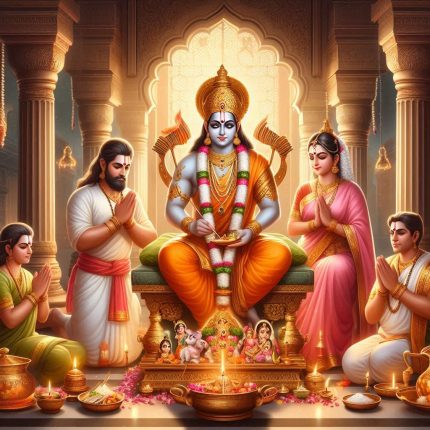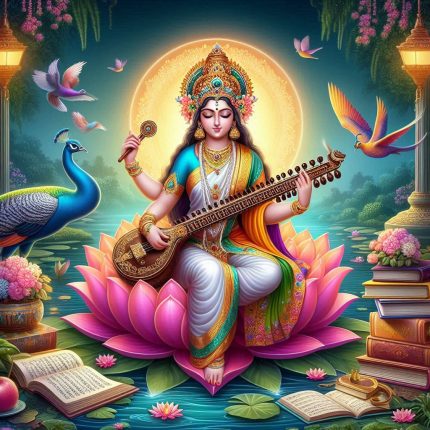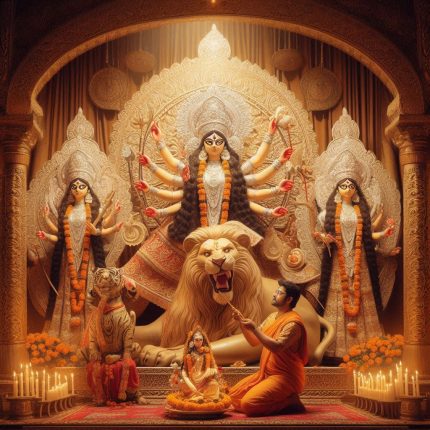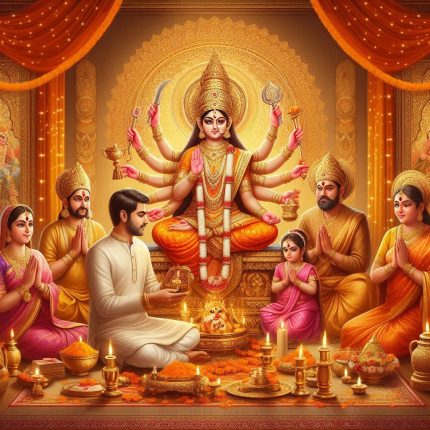Navchandi Puja & Yagya: A Ritual for Divine Blessings and Protection
Samagri
for Puja:
Haldi [organic] (20gm), Kumkum [organic] (20gm), Tulsi Mala (1), Diya Batti (5), Beetle Nuts (5), Desi Ghee (20ml), Honey (20ml), Jaggery (Gudh) (20gm), Akshata [Yellow rice] (20gm), Yagno-paveetha (5), Karpoora [camphor] (5Tabs), Red/White/Yellow Cloth(1 mtr), Prasad [Laung, Elaichi, Mishri] (20gm), Mouli (25mtr), Ganga Jal (15ml), Durva [fresh] (1), Agarbatti (6)/Dhoop (2), Dakshina (100INR), God Idols (pair), Sambrani (2), Sambrani Holder (1), Kalash [small copper] (1), Panchpatra [small copper] (1), Diya Holder (2), Panchamrit spoon (1), Karpoora Holder(1), includes perishables [Beetle Leaves [fresh] (9), Flowers [fresh] (incl mala), Tulsi [fresh], Mango Leaves [fresh] (7)]
Small Havan:
Cow Dung Cake (2), Mango Wood (250gm), HavanSamagri [20+ Grganic Herbs] (100gm), Ghee (20ml)
Yajman to provide:
Curd (100gm), Milk (100ml), Mithai (250gm), Fruits [5types], Coconut (1), HavanKund, SuchiSarva (Havan Spoon) (1), Kalash [big] (1), Bowl [preferably copper/silver] (1), Spoon [preferably copper/silver] (1), Utensils [2 big Plates (for Aarti/Samagri), disposable Plates, Bowls & Spoons], First solid food (preferably Kheer or Payasam)
Importance and Significance of Navchandi Puja & Yagya
Navchandi Puja holds immense significance as it represents devotion to the divine feminine, honouring the goddess’s role in creation, sustenance, and destruction. The ritual aims to invoke the goddess’s presence, seeking her blessings for the well-being of individuals, families, and communities. The Yagya aspect, involving offerings to the sacred fire, symbolizes the surrender of one’s desires and the purification of the environment. Together, these practices foster spiritual growth, strengthen faith, and promote harmony.
Benefits of Navchandi Puja & Yagya
- Spiritual Cleansing: The rituals purify the mind and soul, helping devotees let go of negativity and embrace positivity.
- Seeking Divine Protection: Worshipping Goddess Durga through this puja and Yagya offers protection from evil forces and adversities.
- Attracting Prosperity: Devotees seek blessings for financial stability, health, and overall prosperity.
- Community Bonding: Performing the puja in groups fosters unity and collective spiritual growth among participants.
Occasions to Perform Navchandi Puja & Yagya
Navchandi Puja is especially performed during:
- Navaratri: The nine-night festival dedicated to the worship of Goddess Durga.
- Special Family Events: Such as weddings, housewarmings, or significant milestones to invoke blessings.
- Personal Aspirations: When seeking guidance or support in overcoming challenges.
Navchandi Puja & Yagya Vidhi (Procedure)
- Preparation: Clean the puja area and gather necessary items, including a sacred fire pit (yagya kund), flowers, fruits, ghee, grains, and incense.
- Setup: Arrange the altar with a picture or idol of Goddess Durga, decorating it with flowers and lights. Prepare the yagya kund for the fire ceremony.
- Invocation: Begin the puja by invoking Lord Ganesha to remove obstacles. Light the diya and offer prayers to Goddess Durga.
- Recitation of Chandi Path: Chant the Chandi Path, focusing on the verses that celebrate the goddess’s strength and virtues.
- Yagya Rituals: Offer materials such as ghee, grains, and herbs into the sacred fire while reciting specific mantras. This symbolizes the surrender of desires and prayers to the divine.
- Puja Rituals: Perform aarti for the goddess, offering flowers and sweets as a sign of devotion and gratitude.
- Distribution of Prasad: After the puja, share the prasad (offerings) with participants, symbolizing the blessings received from Goddess Durga.
Navchandi Puja & Yagya Shubh Muhurat
The Shubh Muhurat for Navchandi Puja and Yagya is typically determined based on astrological considerations, with emphasis on auspicious timings during Navaratri or other significant festivals. Consulting with a priest or astrologer can enhance the effectiveness of the rituals.
By performing Navchandi Puja and Yagya, devotees honour the divine feminine and seek blessings for strength, prosperity, and protection. This powerful ritual serves as a reminder of the goddess’s transformative energy, inspiring individuals to cultivate resilience, love, and harmony in their lives.










